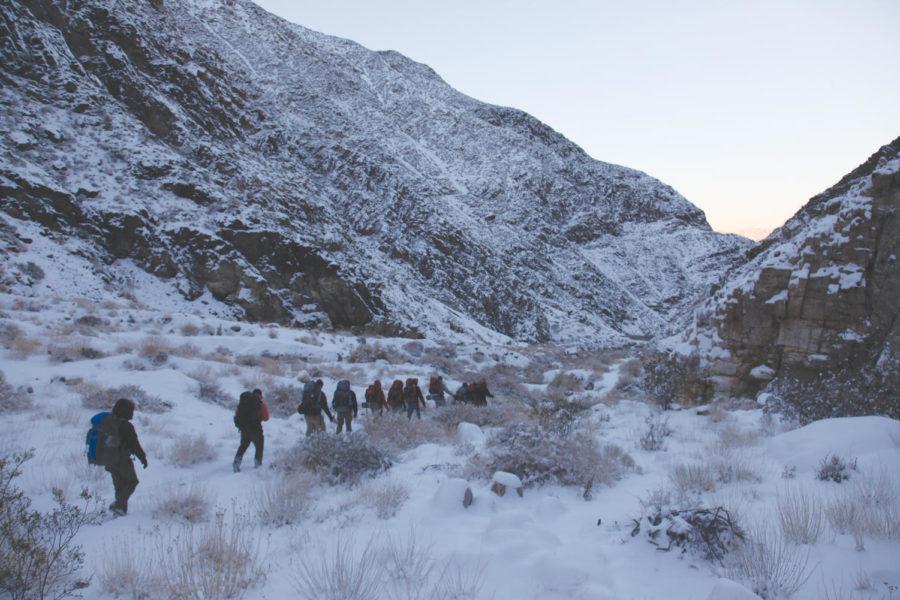Group weathers Death Valley snowstorm, conquers challenges
Members of the ISU Outdoor Recreation Program trip to Death Valley National Park backpack down Surprise Canyon on Jan. 4. The group was hit by a snowstorm as it hiked up the trail to Panamint City, a ghost town at the summit.
January 13, 2011
Furnished with only a wood-burning stove and a few supplies left by previous visitors, the abandoned cabin dubbed “The Hilton” of Panamint City didn’t look like much.
To Matt Nosco and his fellow backpackers, though, it was better than any five-star hotel they could have encountered.
“It was an absolute godsend,” said Nosco, junior in journalism and mass communication. “As we reached the cabin, it was just an instant morale boost when we realized that we had a real shelter there for us to rely on.”
After a 4,000-foot, six-and-a-half-hour ascent up Surprise Canyon in Death Valley National Park, the 12-member group — traveling through the ISU Outdoor Recreation Program — welcomed any reprieve from the falling snow and strenuous hike they’d just endured.
Some unexpected weather
A major snowstorm was the last thing Nosco and his group expected to face as they traveled to Death Valley between Dec. 30 and Jan. 7.
Known as the hottest, driest and lowest place in North America, Death Valley National Park spans three million acres of land covered with canyons, the Panamint Mountains and sand dunes. Each year, there is an average of 2.5 inches of rain fall and temperatures hover around 65 degrees in January.
“We’d looked at the weather for when we were going to be out there and all the reports we’d received were, for the most part, dry,” Nosco said, who was serving as support leader on the trip. “It was going to be cold, colder than we thought … but we had no expectations of [a snowstorm] happening.”
The first warning of a storm came just before the group planned to hike up Surprise Canyon, forcing the hikers to set up camp at a small ghost town called Ballarat at the base of the trail.
“We spoke to this older, kind of eccentric gentleman at the general store there. I don’t know if he was the only one that lived in the town or what, but he told us there was going to be a storm rolling in that same day,” Nosco said. “We made camp there that night and decided to go forward the next day.”
The snow the man warned of didn’t come that night, but the group had no way to check additional weather reports and set out at 10 a.m. the next day. As they ascended the Surprise Canyon trail, a storm system developed in the canyon below, slowly gaining on the group.
“At first it was just kind of light snow, just flurries here and there,” Nosco said. “It started to build and build until we’re just in the middle of it. I don’t know how much snow we got during the ascent, but up at the top it was definitely between 8 and 12 inches in spots.”
Difficult terrain and small streams didn’t help matters, and several hikers faced muscle cramping, fatigue and wet feet.
“There were a number of risks that we were really looking at at that point — frostbite, hypothermia,” Nosco said.
With nothing else in sight, Nosco suggested that the group set up tents in some ruins alongside the trail to the primary leader of the trip, Clark Colby, senior in architecture. However, Colby insisted the group continue.
“Clark was adamant there was something more ahead, so we continued, and thank goodness we did because the rest of the group went off ahead of us and they all reached this cabin that we couldn’t see,” Nosco said.
After six and a half hours of hiking, the group had finally reached Panamint City, a ghost town nestled up in the canyon.
‘An absolute godsend’
Finding the abandoned cabin at the top of Surprise Canyon marked a change in the backpackers’ attitudes, Nosco said.
“People were back to smiles and you could just really see [the mood] gravitate the other way,” he said. “We made sure that people could dry their clothes, got a hot meal going to everybody, and the mood change was just instantaneous.”
The cabin is not cared for by park rangers and remains one of the lasting remnants of Panamint City. A sign on the door described its condition.
“It’s just a visitor-maintained cabin and ranger service does absolutely nothing for it, and it’s up to the people that use it to keep this amazing place going,” Nosco said.
The group also found a logbook in the cabin that detailed the stories of past visitors, many of whom expressed the same sense of relief as the ISU group at finding the shelter after a difficult climb.
“I don’t know that any of them had quite dealt with the weather conditions that we had, though,” Nosco said.
As group members settled in for the night, Colby and Nosco discussed the weather and considered what steps to take next.
“We had icy conditions to think about, but on the other end of the spectrum, we also had the risk of a flash flood because where this town was nestled, there had been one historically before that had actually wiped [a town] off the mountain by flash floods,” Nosco said.
The two decided the group would wait for a partial snow melt before descending the trail, so the next day members rested and foraged for firewood to keep the cabin warm. The relaxing day still included risk, though.
“We knew that staying up there meant risking somebody getting hurt while they were out doing something or it meant we were going to have to wait the whole thing out and the mood would by necessity drop as people got cabin fever,” Nosco said. “We decided we were going to set out the next morning at 5 [a.m.]”
Avoiding disaster
The group woke up before sunrise the morning of Jan. 4.
“We were up at 4 [a.m.], stomached down a quick breakfast and made sure that everyone was very well hydrated before we left,” Nosco said. “We got the cabin all cleaned up and did what we could to take care of it and add to it in our own way.”
At the top of Surprise Canyon, a foot of snow covered the ground and trail, so the group hiked down in order of footwear. Nosco led the descent.
“We’d repurposed a piece of old piping from the cabin as a walking stick for me since I was out in front. I had to be feeling in front of me to have good support since I was on very uneven ground that I couldn’t see,” he said. “[The snow] was literally almost up to my knee at parts, knee to shin, and we made it so the people with the best footwear wore it down for the people behind them.”
Because it was still dark, it was difficult to see the trail, but the group was helped out by an unlikely source.
“We weren’t sure if they were mountain goats or burros that live in the area — a donkey-like animal — but these tracks led us perfectly along the trail,” Nosco said. “These tracks led us perfectly down the trail, and not only did they show us where the trail was, but they also pinpointed the exact best spot on the trail for me to walk. It was outrageous how well this worked out.”
The descent took about five and a half hours, and the group lost the trail several times because it was covered with snow.
“We got hung up at a few spots for 20 to 30 minutes, which was kind of frustrating for everybody,” Nosco said. “But we ultimately made the descent injury-free.
“It would make for a lot better story if something more eventful had happened, but thank goodness nothing did.”
A satisfying end
When the group reached the bottom of the trail, members experienced a feeling similar to the one they felt at the top of the canyon.
“The feeling of relief when we passed that last waterfall, there’s no way to describe it. It was just the same feeling of relief as when we found the cabin,” Nosco said. “Without that cabin, I really don’t know how things would’ve gone. I think we might have still gotten out of it safely, but I know that it would have been a lot more miserable.”
Despite the snow, fatigue and challenges, the trip was worth it to Nosco.
“I looked back up at the mountain [after we finished the descent], and I always want to say that I’ve conquered something in nature. My boss Jerry has warned me about that before — you don’t want to say you’ve conquered nature because you’re never actually going to conquer it, hopefully never leave any lasting imprint on it.
“But I feel like we definitely conquered the challenges put in front of us, which was really satisfying.”

















